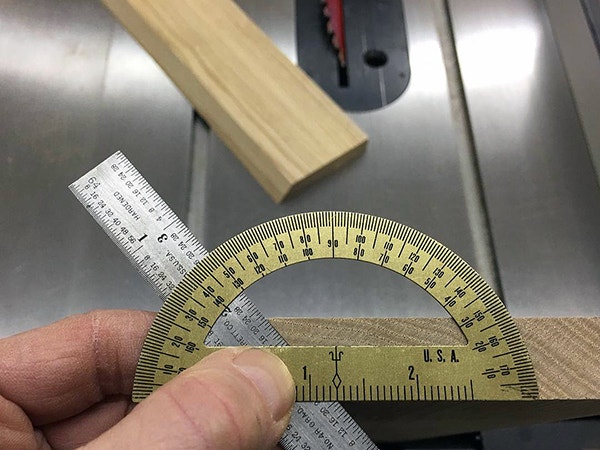Ripping a 50-degree Bevel Angle?
I am making a replica of a church, and the angle at the apex of the front of the church is 100 degrees. I want to bevel the two roof edges to fit, but the length of the wood will not fit into my band saw throat. How do I make a bevel miter on the edge of a piece of wood that is greater than 45 degrees? Any help will be greatly appreciated. - Bill Gunkel
Chris Marshall: Let's see if I’m understanding the predicament accurately here, Bill. You need to make a couple of beveled rip cuts with your band saw table tilted to cut the ridge angles on the roof panels. The combination of those ripped angles needs to add up to 100 degrees, which is why you want the table to tip further than 45 degrees (ideally, I’ll bet you're wishing, it tilted to 50 degrees). It won’t, and to make matters worse, your saw’s throat won't allow for workpieces this wide anyway.
First off, if you have access to a table saw, I'll suggest making these rip cuts there instead, where the table stays horizontal so you can maintain optimal control. Making bevel-rip cuts on a band saw with the table tilted to a steep angle is precarious -- especially if the rip fence has to be on the "uphill" side of the table where there's more surface area and the workpieces are large. Don’t work against gravity unless you have no other choice. Plus, a table saw won't cramp your space like a band saw's throat can.
Second — and I hope this will come as good news! — you don't need a special setup or jig to achieve the 50-degree angles on the edges of your roof panels. Any conventional table saw can get the job done. All you need to do is tilt the blade to 40 degrees and make those bevel-rip cuts. Why? Well, the saw's bevel tilt scale is measuring tilt in terms of the number of degrees the blade is tipped off of vertical. The complementary angle left on the cut edge of the wood is 90 degrees, minus the tilt angle. So, for instance, if you're making a beveled rip cut and the blade is tilted to 10 degrees, an 80-degree angle will be left on the cut edge. Tilt to 20 degrees, and a 70-degree angle will be left on the wood. Keep cranking to 40 degrees, and a 50-degree angle will be left on the wood. So, rip each of your roof panels with the blade tilted to 40 degrees, and, voila! You'll have two 50-degree beveled edges to form the 100-degree apex angle that you need for your church replica (that's just what I did in the photo, above).
Tim Inman: There are any number of ways to make a cut like this. But since I'm the "Official Old Guy" now, my answer is going to be "old-school." Sometimes you just can't beat an old fashioned "whoompa" hand saw. For this job, I would couple a good, sharp handsaw with a purpose-made miter box and go for it. My father and I frequently made little special-purpose jigs like this to get jobs done. He and his brother worked together for many years doing built-in cabinets, bookcases, staircases and so forth. On-site work often requires a creative instinct! A couple of blocks of wood, a little time scratching the side of one's head, and some trial and don't-be-discouraged testing are required. In fact, I find that many times, even in my own nice shop with just about every tool I can think to own, it is not uncommon that I resort to making up a special jig or fixture for a given project. Made-for-the-purpose miter boxes are a great thing to use and to know how to make. Second choice? A good portable circular saw and a straightedge to follow. If you're making a compound miter like a hopper joint, just angle the blade and follow the straightedge — and Bob's your uncle.
Keep the inspiration coming!
Subscribe to our newsletter for more woodworking tips and tricks





